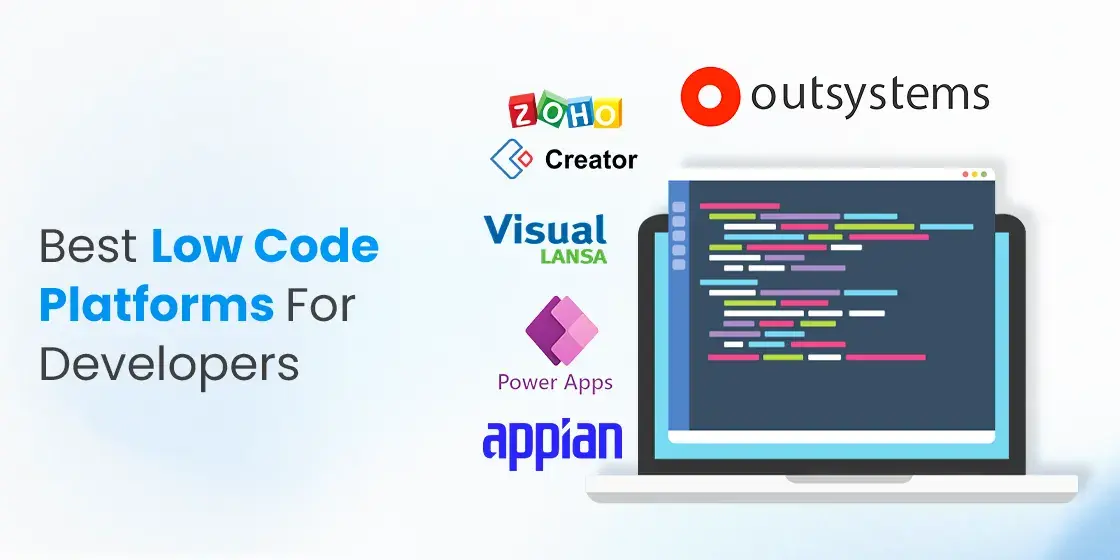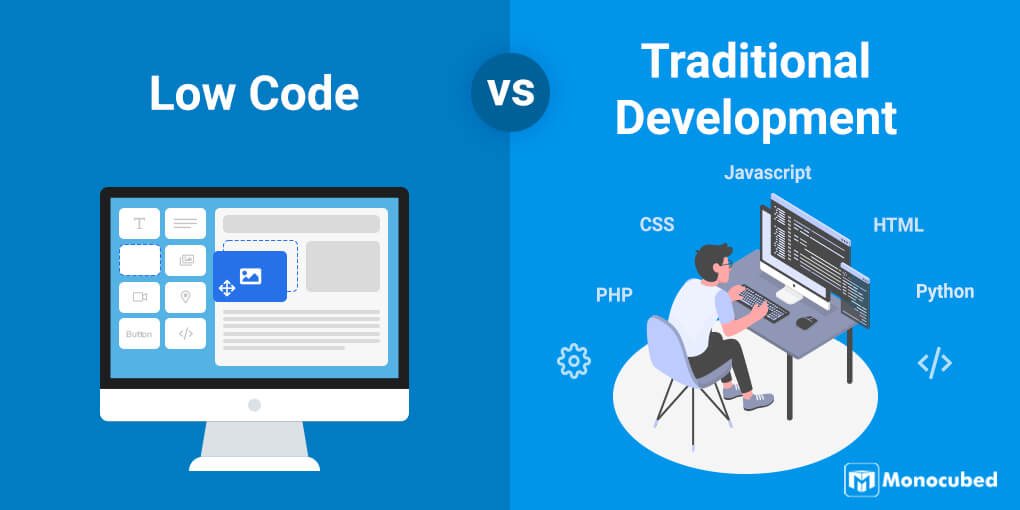Handy Advice To Selecting application development with Low-code platforms
Handy Advice To Selecting application development with Low-code platforms
Blog Article
Benefits Of Low-Code Application Development In Terms Of Integration Capabilities
Low-code app development has many benefits, especially in terms integration. This is essential to create applications that seamlessly connect to platforms and services. Here are some of the benefits that come with pre-built connectors, APIs as well as other tools:
Many Connectors Low-code platform typically comes with an array of connectors that are pre-built for the most popular enterprise applications (e.g. databases, CRMs ERPs, cloud-based services, and more). Integration of the systems can be made easier.
API Integration: A lot of low-code platforms include out-of the-box integration API capabilities which allow developers to connect easily with external data sources and services.
Ease of Use:
Integration via Drag and Drop Integration tasks are usually completed using drag and drop interfaces. Developers and non-developers can create complex integrated systems without writing code.
Visual Workflow Builders: Tools to create workflows and data flows that visually represent help comprehend and setup integrations in a much more simple method.
Standardized Integration Methods:
SOAP and restful services that support web services standard protocols such as REST and SOAP makes integration easy with an array of software and systems.
OData and various Standards Standards that support them such as OData allows for simple access and manipulation of data on different platforms and applications.
Real-Time Data Synchronization:
Real-Time Integrations: Low-code platforms can handle real-time data sync between systems and applications. This ensures that information is current and consistent throughout the organization.
Event-Driven architecture: Some platforms can support event-driven architectures. This allows applications to react to events in real-time that is vital for interactive and dynamic apps.
Legacy System Integration:
Interconnecting Old and New Systems Low-code platforms usually include tools for integration with older systems, which allows organizations to modernize their IT infrastructure without radically overhauling the existing system.
Data Migration Tool: Built-in migration tools allow the data to be transferred from older systems to new applications that run on low code platforms.
Third-Party Services Integration:
Cloud Services Integration: Easy scaling and deployment of applications can be achieved through seamless integration with cloud services such as AWS, Azure and Google Cloud.
Business Applications Low-code platforms can be used to integrate with various applications for business, such as Salesforce, SAP or Microsoft Dynamics. They allow a cohesive workflow for different business processes.
Simple Data Management
Data models that are unifying: Certain platforms that offer low-code support unified data model to facilitate data management across platforms.
Data Connectors: Data connectors that are pre-configured to provide easy access and manipulation of data derived from different sources.
Security and Compliance
Low-code integration platforms meet security standards to protect data while in transit or at rest.
These platforms are typically packed with features to ensure conformity (e.g. HIPAA, GDPR) and give assurance to companies handling sensitive information.
Extensibility:
Low-code platforms can often accommodate complicated integration requirements by incorporating custom scripts or code. They provide flexibility, but without sacrificing their user-friendliness.
Plug-in Ecosystem A collection of plugins and extensions that can enhance the integration capabilities, allowing users to add new functions as needed.
Low-code platforms are a powerful tool to create interconnected, efficient and scalable apps. They are able to streamline the process of connecting disparate systems, and increase the flow of data. Businesses can also leverage existing technology and implement new ones while maintaining a unified IT environment. Check out the best Low-code Platform for application development tips for blog recommendations including sso azure, developing mobile apps, push alerts, push notifications, push alerts, develop cross platform mobile app, ms azure sql, build a docker container, jdbc server, app dev platform and more.
Low-Code Application Development Offers Many Benefits In The Area Of Cost-Effectiveness.
Low-code development offers many advantages in terms of cost-effectiveness. This is a great option for companies who want to reduce their development budgets while still providing top quality software. Here are the major benefits:
Lower Coding Requirements Low-code platforms eliminate the requirement for extensive hand-coding, reducing the time and effort that developers must to spend on building applications. This results in lower costs for labor.
We require fewer resources for developers: Programming with low-code is easier and faster, so fewer developers with specialized skills are needed. This could drastically cut the cost of hiring and staffing.
Quicker time to market:
Accelerated cycle of development: Visual development tools as well as pre-built components provided by platforms with low-code support rapid design of applications, which allows firms to bring their products to market faster. This will result in faster revenue generation and better position in the marketplace.
Rapid prototyping. By rapidly creating and testing prototypes, companies can cut down on time spent development and iterate faster based on feedback from users.
Lower Maintenance Costs:
Simple Maintenance: Software developed on low-code platforms tend to be easier to maintain due to their standardized components and modular architecture. This reduces the ongoing maintenance and support costs.
Automated Updates Many low-code platforms are capable of handling updates and patches in a manner that is both secure and timely. This means there is no requirement to manually intervene.
Efficient Resource Utilization:
Platform contributions that are low-code let businesses as well as other non-developers participate in the process of creating. This allows companies to benefit from the skillsets of a wide spectrum of employees.
Optimized Use of IT Resources: IT departments can focus on more strategic initiatives instead of being slammed with mundane development tasks which can increase overall productivity and efficiency.
Scalable pricing models:
Subscription Pricing: Many platforms with low-code support different pricing options based on subscriptions which are scalable depending on the usage. This allows businesses to match their spending to the actual requirements and growth, avoiding large upfront costs.
Pay-as-you go options Certain platforms offer pay-as you-go options that ensure that companies only pay for the services they use that are advantageous for small and start-up companies with a limited budget.
Costs of Third-Party Software reduced:
Built-In Functionalities: Low-code platforms typically come with built-in functions and integrations that reduce the requirement for third-party software and tools, which results in savings on licensing fees and subscription costs.
Pre-Built Integrations: The accessibility and pre-built integrations with popular applications and systems reduces the need for custom development and saves time and money.
Improved ROI
Increased ROI: Businesses will gain a greater return on investment from applications that combine rapid development, less expensive and a faster time to market.
Improved agility: Companies can adapt quickly to changes on the market or in customer demand which enables businesses to stay relevant and benefit from new opportunities.
Lower Cost of Training
User-Friendly Interfaces: The simple interfaces and user-friendly features of low-code platforms minimize the learning curve, thereby eliminating the need for extensive training.
Accessible Resources. Many low-code platform offer comprehensive training material, tutorials, as well community support. They make it less necessary for formal education, which can be costly.
Streamlined collaboration:
Enhanced Collaboration Tools: The collaboration tools that are built into the software aid in collaboration and communication between the team members. This results in more efficient project development process as well as lower costs.
Unified Development Environment: A single unifying development environment can help improve workflows and reduces complexities and costs associated with managing multiple platforms and tools.
Low-code development is cost effective because it lowers maintenance and development expenses. It also accelerates time to market and optimizes utilization of resources. Pricing models can be adapted. These factors combine to deliver huge financial benefits to companies and make low-code development a viable choice for organizations aiming to increase their budgets for development while also delivering high-quality, flexible high-quality and robust applications. Follow the most popular Legacy application modernization with Low-code recommendations for site info including driver jdbc, develop mobile application, driver jdbc, application modernization, azure sql databases, rapid application design, software for app development, application modernization software, develop cross platform mobile app, app development platform and more.
Benefits Of Low-Code Application Development In Terms Of Community Support And Vendor Support
Low-code platforms for application development have major advantages in terms the support provided by vendors and communities, which are essential for successful implementation, ongoing maintenance, and continuous improvement of applications. Support from the Vendor
Comprehensive Technical Support:
Support Teams Dedicated to You Numerous low-code platforms provide dedicated support teams who can help in technical problems, problem solving and provide guidance. This ensures that any issues will be quickly addressed.
24/7 Support Availability: Some suppliers provide support 24/7 that is especially beneficial for businesses that operate globally and in different time zones.
Training and Onboarding
The structured training programs offered by vendors offer structured courses like webinars or courses for certification. This helps users quickly master the platform.
Personalized Onboarding: Many companies offer personalized onboarding to assist new customers use the platform efficiently and adapt it to meet their needs.
Regular Updates and enhancements:
Continuous Improvement: Lowcode platform vendors usually issue regular updates that include new features, improvements to performance, and security patches. This ensures that the platform is current and safe.
Feedback Integration: A lot of vendors integrate user feedback in their process of development. This helps ensure that the platform adapts to the evolving needs and wants of their users.
Comprehensive Documentation:
Documentation is thorough: Users are usually able to access extensive and well-organized documents, which range in terms of complexity from basic customization to advanced.
API References API documentation can aid developers build and integrate apps with the Low-Code platform.
Professional Consulting Services
Expert Consulting : Vendors offer consulting services, such as designing architecture and complex implementations. They do this in order to make sure that their users are able fully benefit from the platform.
Custom Development Services Certain vendors offer custom development services in order to create specific integrations and features that are not included in standard.
Community Support for the Community
Active User Community:
Forums and discussion boards Forums and discussion boards: Many platforms that are low-code have vibrant online community for users to ask for help, share solutions, and work together to discover the best practices.
User Groups & Meetups Virtual or local user groups and meetings offer opportunities for learning, networking and sharing knowledge.
Knowledge Sharing and Collaboration
Community-Contributed Resources: Users often share templates, modules, and extensions that they have developed, which can be reused or adapted by others, accelerating development and innovation.
Crowdsourced Problem Solving: The collective wisdom and experience of the community can be a valuable source of troubleshooting and figuring out creative solutions for complicated problems.
Learning and Development
Community-led training A lot of community groups offer training sessions, webinars, and workshops facilitated by experts who are experienced in the area.
Online Tutorials and Courses Members of the community frequently make online tutorials, courses and tutorials on how to accomplish things, which enhances learning resources.
Feedback and Influence:
Product Feedback: Many forums offer channels to give feedback to vendors. This feedback can affect the development of new features and enhancements.
Beta Testing Programs: Active community members might be able to be part of beta testing programs, giving the opportunity to test new features and an opportunity to participate in influencing the evolution of the platform.
Recognition and Encouragement
Many vendors offer community recognition programs. These programs reward active community members, and can include MVP programs.
Peer Support: Community members typically provide peer support, sharing their expertise and providing guidance for users who aren't as experienced in a supportive and a supportive atmosphere.
Overall the combination of strong vendor support and an active, engaged community provides an entire support network for low-code application development. Users will be able access the resources, experts and collaboration opportunities they require to develop and deploy, manage and improve their applications.
